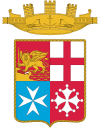History
The first four hulls were ordered by the Italian Ministry of Defense (NAVARM) on 21 December 2007, [4] for €3,992,000. The fifth hull was ordered by NAVARM on 9 November 2009. The last four hulls were ordered by NAVARM on 21 December 2010.
The LCM62 class is designated by Vittoria Shipyards as the C828 class and is a vehicle crafted to support amphibious military action. The boats were designed for the transport of troops and ground vehicles, as part of landing operations on the coasts. These models are required and employed by all major navy forces, for their versatility and safety features guaranteed by the ballistic protection of the cabin. The hull and superstructure construction material is steel AH36. The closed and air-conditioned wheelhouse can accommodate up to three sailors. The wheelhouse and the front ramp door are equipped with ballistic protection against NATO 7.62×51mm A.P. bullets.
The MTM (Motozattera Trasporto Mezzi)-class landing crafts LCM62 have been developed by Studio Fast Service [5] and Vittoria Shipyard [6] for the Italian Navy. Nine of these crafts are operated aboard the three San Giorgio-class ships and are used by the San Marco Marine Brigade at Brindisi Naval Station homeport.
This page is based on this
Wikipedia article Text is available under the
CC BY-SA 4.0 license; additional terms may apply.
Images, videos and audio are available under their respective licenses.

